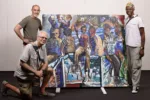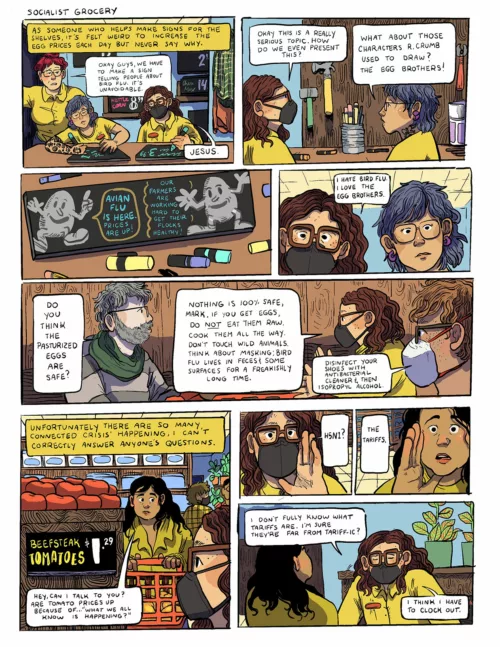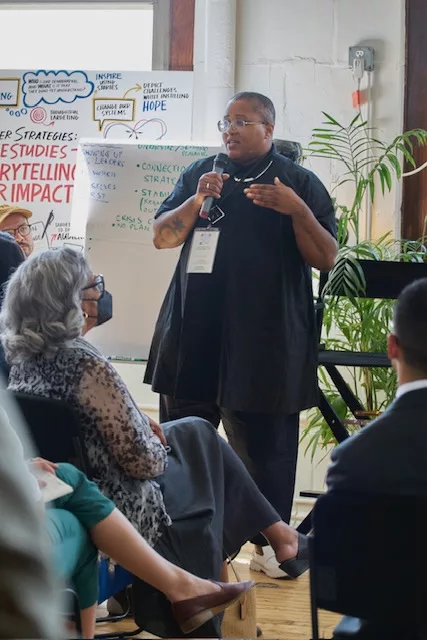
Author’s Introduction
I interviewed Sloan Leo Cowan (they/he) on a rainy day in his fabulous West Philadelphia home. Sloan Leo is a community designer who founded FLOX Studio Inc., a community design and strategy studio. He is currently CEO and Lead Facilitator of the studio. As a writer, speaker, artist, and teacher, Sloan Leo keeps busy while still finding time for his community in West Philadelphia and New York City. We sat down and discussed the boundaries between facilitation and design, and community design as an integral function of interpersonal collaboration.
Max Van Cooper: What does community design mean to you?
Sloan Leo Cowan: Community design didn’t mean a ton to me as a term until I needed it. I think of community design as referring to what feels organic, but is actually a process. That a group of people who have a shared resource—which is how I define community, so it can be a community of interest, a neighborhood, a school—decide what to do with the resource, how to maintain it, make decisions, and collaborate.
Max: How does visual design intersect with community design?
Sloan Leo: I think about aesthetics, so the way a room looks where communities have events. Or I think about when your friend sends you an invitation for a dinner party. I think of design as an aesthetic, as being the thing that often opens the door to conversation. It’s often the way into community.
Max: It helps facilitate the community or the conversations around it.
Sloan Leo: It’s interesting you use the word facilitation, because I was talking to a friend recently about what undergirds the foundation of movements—which is often the community—is facilitation. Facilitation is the undersung hero of how we organize. Everything is actually facilitation, from the literal meaning itself, to the invitation that you create, to the food that’s there, to the music and places to sit.
All of the infrastructure of community is actually rooted in ideas and modes of facilitation. So I think of facilitation as what it means to do design.
When I was teaching—I teach at SVA [School of Visual Arts] and at the New School—a lot of what I teach is that designers are actually facilitators. Whether they’re doing that in a consulting firm or if they’re doing that in their neighborhood.
Max: Tell me a bit about how you came to find yourself as a facilitator.
Sloan Leo: I realized that I liked having a role when I was in a social situation, and so over time I realized that I have a pretty grounded countenance or temperament, and that in my friend group, in spaces of community outside of my friend group, I was often kind of like trying to hold and maintain the shape of a conversation.
And my dad was a facilitator and my mother was a facilitator, though this wasn’t their job title. But that was what they functioned as. And so when I started my business FLOX Studio in August, 2020, I thought, the thing I’m most really known for in my community is actually helping to hold and facilitate conversations.
Max: I am so struck by just the idea of coming from a family of facilitators. What a beautiful legacy.
Sloan Leo: I feel the same way. My grandfather played a really important role in how I think about what facilitation is. He was a Black Baptist minister outside of Chicago and outside of Indianapolis. And his definition of his work was really as to steward, to shepherd, to bring a group of people through a thing. And isn’t that a very pure act of facilitation also?
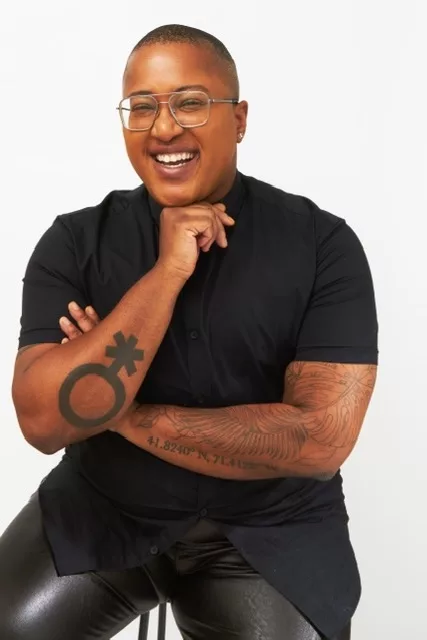
Max: Speaking of FLOX Studio, what is FLOX Studio and where do you see it growing in the next five years?
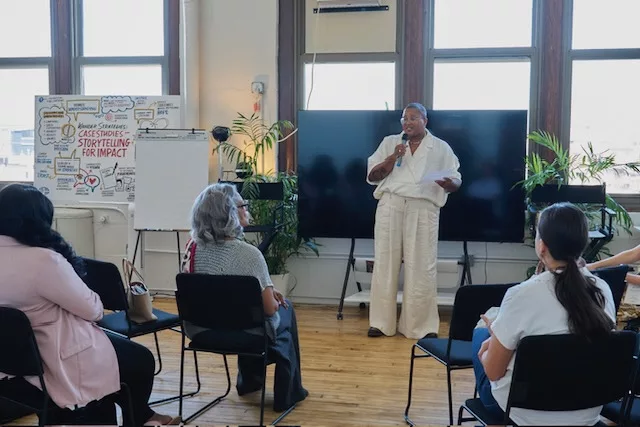
Sloan: Well, FLOX turns five next year, and FLOX is a community design and strategy studio. What that means in everyday-speak is that we do a couple of different things.
One is that I’ll facilitate retreats for nonprofits: staff retreats, board retreats, leadership team retreats—retreats, meetings, gatherings.
We also do strategy about what community looks like. So we’re working with a group right now where they’re like a group of donors. How do they enter that community? How do they exit the community? How do they build relationships between themselves and the institution? So it’s that strategy of how do you build community with intentionality and care? How does an organization act as a community to shepherd in and steward a future?
And you were asking me how, where do I see FLOX Studio in five years. In my dream world, FLOX is really a laboratory or an accelerator for new ways of facilitating and for building community facilitation capacity.
For a couple years we’ve done a FLOX facilitation school where I train people on the various types of facilitation. I want to do a lot more of that. I also want to write a book about the history of facilitation, and one that really is anchored in what Black feminist facilitation looks like.
Max: What do you see as the boundaries between art and social change?
Sloan Leo: There’s so many eras of artists who would say art and social change should stay separate. And I don’t agree with that. I think that creativity isn’t just used for social change. I think it comes from social friction in the sense of unfairness, injustice, or strong emotion.
What creates artistry is often deep sadness, deep happiness, emotional strife. And those tensions are so present in our society and in our species, especially right now. So I think of art as a way that people kind of grapple with the friction of life. And then turn it into something that can become a point of conversation.
And actually there’s also a relation between that and facilitation. Sometimes I’ll have someone read a part of a poem at a facilitation, and ask and invite people in that room to see that as a starting point for a conversation about accountability, care, or justice. And it gives people a way in.
Max: How can community design create a sense of belonging in a fractured society?
Sloan Leo: I think that having a role helps people feel less fractured. Sometimes your friend group or your community will be having a conflict and something harder will happen, like someone loses their job and, if you’re in your friend group, everyone’s been fighting.
But at some point you’re all like, oh, we all need to do something to make sure that this person isn’t now unhoused and has money for groceries. And you show up for each other at that moment. And so I think that the way community design operates is that we’re all doing something together. I see it as a tool for repair, strengthening, and building like collective resilience.
Max: What does community design look like in Philly?
Sloan Leo: Community design in Philly, which is like such a beautifully Black and also deeply under-resourced city, looks a lot like figuring out how to share resources.
Which is true I think for a lot of economically disadvantaged communities, which as a Black queer person is all of my communities. And so it’s figuring out, how do we share clothes? What do I do with this couch that I don’t need anymore? When I moved here about a year ago, I started to kind of giggle at all the barter economy that exists on everyone’s stoop. And community design is building these opportunities or spaces to share.
Max: I love that you mentioned how some of that community design is so organic and spontaneous. It’s naturally how we interact with each other.
Sloan Leo: I like community design because I think of it as it gives language to things that are happening.
There’s a really amazing designer named Dr. Christina Harrington, who did a project called the Denizen Designer Project, and basically Christina went around and talked to people who were organizers, activists, social workers, teachers, facilitators, therapists, and asked them about what’s community, what’s design, and how do those things fit together in your world? And people were able to identify themselves and say, oh, I’m a designer.
And I think it’s part of the big thing that I love, and that is a really big takeaway for me is that I didn’t go to design school. I didn’t know what design meant, but I was a fundraiser, an organizer, a facilitator, a confidant to many people for many things. And in that process I was able to start identifying through the language of community design. I’m a designer.
https://sloanleo.com/
https://www.floxstudio.com/
Read more articles by Maxwell Van Cooper on Artblog.



